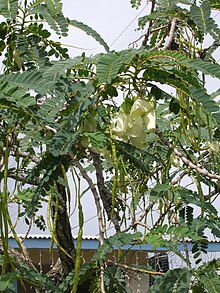West-Indian pea
| Sesbania grandiflora | |
|---|---|
 |
|
| Scientific classification | |
| Kingdom: | Plantae |
| (unranked): | Angiosperms |
| (unranked): | Eudicots |
| (unranked): | Rosids |
| Order: | Fabales |
| Family: | Fabaceae |
| Genus: | Sesbania |
| Species: | S. grandiflora |
| Binomial name | |
|
Sesbania grandiflora (L.) Poiret |
|
| Synonyms | |
|
|
| Nutritional value per 100 g (3.5 oz) | |
|---|---|
| Energy | 113 kJ (27 kcal) |
|
6.73 g
|
|
|
0.04 g
|
|
|
1.28 g
|
|
| Vitamins | |
| Thiamine (B1) |
(7%)
0.083 mg |
| Riboflavin (B2) |
(7%)
0.081 mg |
| Niacin (B3) |
(3%)
0.43 mg |
| Folate (B9) |
(26%)
102 μg |
| Vitamin C |
(88%)
73 mg |
| Minerals | |
| Calcium |
(2%)
19 mg |
| Iron |
(6%)
0.84 mg |
| Magnesium |
(3%)
12 mg |
| Phosphorus |
(4%)
30 mg |
| Potassium |
(4%)
184 mg |
|
|
|
|
|
| Percentages are roughly approximated using US recommendations for adults. Source: USDA Nutrient Database |
|
Sesbania grandiflora (syn. Aeschynomene grandiflora, Agati grandiflora), commonly known as vegetable hummingbird,agati or hummingbird tree, is a small tree in the genus Sesbania.
It is a fast-growing tree. The leaves are regular and rounded and the flowers white or red. The fruits look like flat, long, thin green beans. The tree thrives under full exposure to sunshine and is extremely frost sensitive.
It is a small soft wooded tree up to 3–8 m tall. Leaves are 15–30 cm long, with leaflets in 10–20 pairs or more and an odd one. Flowers are oblong, 1.5–10 cm long in lax, 2–4 flower racemes. The calyx is campanulate and shallowly 2-lipped. Pods are slender, falcate or straight, and 30–45 cm long, with a thick suture and approximately 30 seeds 8 mm in size.
It is indigenous from Malaysia to North Australia, and is cultivated in many parts of India and Sri Lanka. It has many traditional uses. It grows where there is good soil and a hot, humid climate.
The leaf extract may inhibit the formation of advanced glycation end-products. The leaf extract contains linolenic acid and aspartic acid, which were found to be the major compounds responsible for the anti-glycation potential of the leaf extract.
The flowers of S. grandiflora are eaten as a vegetable in South Asia and Southeast Asia, including Laos, Thailand, Java in Indonesia, Vietnam, Sri Lanka, and the Ilocos Region of the Philippines.
In the Thai language, the flowers are called ดอกแค (dok khae) and are used in the cuisine both cooked in curries, such as kaeng som and kaeng khae, and raw in nam phrik.
...
Wikipedia
